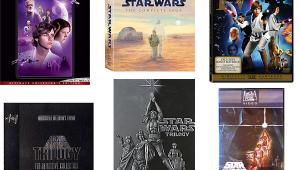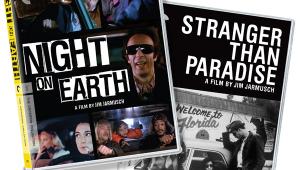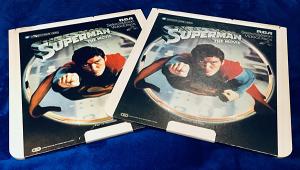Complete Matrix Trilogy - HD DVD

The fact that each of the films is contained in its own standard HD DVD case suggests that at some future date the films will be sold separately. It's also a near certainty that Warner Brothers will also release the films on Blu-ray disc. But not yet. If you want the movies in high definition, the only way to get them, for now, is by purchasing all three of them together in this HD DVD set, at a list price of $99.99.
Actually, there is another way. This set has three single-sided discs. If you are truly obsessed by The Matrix and its two sequels, and want more extra features than the exhaustive ones provided here, you can up the ante to $119.99 for a five, two-sided disc version, the Ultimate Matrix Collection. Warner did not send us the latter, so we can't say from experience say that the audio/video transfer of the films is identical on both sets. But according to Amazon they are both newly remastered, so it's safe to assume that they are the same.
The Matrix was a phenomenon with it was released in the summer of 1999. A head-trip of the first order about a world that exists only in cyberspace. While there were several similar films produced around the same time (the best of them, to me, was The Thirteenth Floor) none of the others had nearly as much action or were as skillfully made.
The Matrix also gave birth to the two sequels in this set. Both were released several months apart in 2003, and neither was as good as the original. The first of them, Matrix Reloaded is primarily a well done action spectacle that also raises the questions, "If Neo can fly, why does he bother to go mano a mano a mano a….with Agent Smith before taking to the sky?" and, "With only a few days to go to possible oblivion, why are the inhabitants of Zion frittering away valuable time with an all-night Rave?" and, "Who is the lucky guy with the Matrix and Zion Sunglass Hut concessions?"
The second sequel, Matrix Revolutions, is a narrative mess, not to mention the fact that we spend maybe 15 minutes in the Matrix during the whole 2-plus hour running time.
In fact, with tighter editing the filmmakers could have compressed the two sequels into a single, dynamite, 3-hour saga that would have eclipsed the original. They could have deleted about an hour of the endless martial arts scenes, for starters (a little of Keanu Reeves showing off his martial arts stances goes a long way). They could have also cut out the Rave, plus about 15 minutes of an interminable car chase that's a centerpiece in Reloaded (it's an extremely well done car chase, however).
But methinks I curmudgeon a bit too much. All three movies are full of yummy eye-candy, spectacular and truly original special effects, and crunching action sequences. And the fact is that these movies have a huge fan base. Even with their flaws they are terrific entertainment.
I won't waste bits here explaining the plot. Most of you know it by heart already. You might even have written a doctoral thesis on it (I'm sure someone has). The rest of you will enjoy it far more if you discover it for yourself.
The real news here for home theater fans, however, is the quality of the transfers. The video is dynamite. In The Matrix you can see every pore in every actor's skin. You can even count Laurence Fishburne's acne scars during the slow parts (though there aren't many of those—slow parts that is)! But the image never looks artificially enhanced. Shot after shot—closeup, medium shot, long shot—is about as sharp and detailed as film photography and current video technology allows.
The two sequels look nearly as good, though very subtly less crisp. There are a few more random soft shots here and there. The sequels, though released several months apart, were filmed together in what must have been a more highly pressured shoot, full of the sort of huge expectations that never hampered the unheralded first film.
My review sample, disappointingly, froze in a couple of spots. But when I scanned back and ran through the same sequences again, I could not repeat the problem. The anomalies might have caused by my player, but it has only glitched like this handful of times in the year I have owned it.
All of the films look far better on these discs than they did when I first saw them at premier-quality theaters in Chicago and Los Angeles. The colors, though subdued for most of the running time (including a subtle green tint for the scenes that take place in the Matrix) are spot-on. Blacks and shadow details are outstanding, particularly in the first film.
There's also very little noise and grain. That's just a little suspicious; I remember the films being a rather grainy in the theater. But I don't see that here. Were the theatrical prints I saw less than the best (very possible), or has the noise and film grain been filtered out in these transfers? If it was, there's no sign of the sort of image softness that filtering might produce. All three movies look stunning from beginning to end.
All three discs have both Dolby TrueHD and Dolby Digital Plus soundtracks. Even the DD+ tracks, which I auditioned courtesy of the DTS conversion in my Toshiba HD-A1 DVD player, are spectacular. The sound excels not only in the dynamic scenes, of which there are many, but in subtleties as well—from their music tracks (apart from the obnoxious and inappropriate heavy metal scoring that wails over the end credits in the first and second films) to the beautifully done sound effects and Foley work. The sound is just slightly more open in the first film than in the second two, probably because it's a bit less complex. But it would be petty to complain.
I won't go into detail on the extensive extra features offered here; you can read about them in the gazillion Internet sites that obsess over such things. But there is one unique feature that we've long been promised on HD DVD: the In-Movie Experience. It overlays a moving, thumbnail image onto the lower corner of the film, accompanied by an additional audio commentary. It's present on all three films and is most effective when it actually shows you something about how the scene in the film was created. It's least useful when it simply reverts to a talking head commentary. And there is one issue here for the two readers who may be using a 2.35:1 screen for constant height playback: The thumbnail image extends slightly beyond the lower border of the 2.35:1 movie image. The bottom 15% of it will be cut off by your screen. This is not a problem with a 16:9 set or a 16:9 projection screen.
Will this boxed set be the big, killer AP that we've all been waiting for to give HD DVD, or Blu-ray, a real kick into the mass market? Maybe—though I personally believe that either Star Wars saga or The Lord of the Rings trilogy will, when they ultimately arrive on HD disc, be even bigger. But regardless, this is a must-have set for every fan of high definition on disc. And if you're a fan of the movies as well, you're probably in line at your favorite video store already.
The Matrix ....Film: 9.0 (out of 10)…Picture: 10.0…Sound: 9.5
Matrix Reloaded ....Film: 7.5 (out of 10)…Picture: 9.5…Sound: 9.5
Matrix Revolutions ....Film: 7.0 (out of 10)…Picture: 9.5…Sound: 9.5
(Reviewed on a JVC DLA-RS1 1080p projector and Stewart Studiotek 130, 78" wide, 16:9 screen, with a Toshiba HD-A1 HD DVD player, Denon AVR-4306 AV receiver, Revel B15 subwoofer, and Aperion 633-T L/R (newest version), 634-VAC center, and 632-LR (surround) speakers.
- Log in or register to post comments






























































